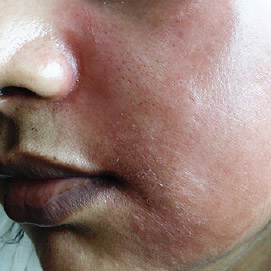Healthcare experts are warning consumers to steer clear from skin-lightening products (SLPs) for the safety of their health. The 2020 CNN investigation on SLPs revealed dangerously high concentrations of some unlisted ingredients that can have detrimental complications to their users.
Hydroquinone, a potent skin-lightening agent used for hyperpigmentation treatments, can cause permanent blue-black facial discoloration or skin thinning with high-dosage application, said Dr. Desai, a board-certified dermatologist at University of Texas Southwestern Medical Center.
Figure 1: Blue-black discoloration from long-term usage of hydroquinone-containing products. Source: Taylor & Francis Online
Recently, optometrists at two corneal clinics in the UK had diagnosed three patients with corneal degeneration – a condition which leads to a loss of vision overtime, most likely from using hydroquinone-containing products for the past 3 to 15 years.
Corticosteroid, the most popular topical steroid for skin-inflammation conditions, also has a very potent bleaching effect. Chronic misuse of corticosteroid over an extended period of time at any dosage results in steroid dependent reactions – rashes, increased skin sensitivity to sunlight, and infections occur when a patient discontinues using topical steroid.
Figure 2: Topical Steroid Dependent Face (TSDF). Source: CNN
Mercury, another dominating ingredient in many unregulated skin-lightening products which inhibits the production of skin pigmentation to reveal a lighter complexion. And in a note from the Pan American Health Organization, the well-documented list of associated risks from mercury poisoning does not look so pretty.
Prolonged exposure to mercury ranges from organ failures such as kidney, liver, brain, and eyes, to psychological issues such as psychosis, depression, anxiety, and early-childhood development issues.
Moreover, the determining factors when assessing a patient’s health on the severity of mercury exposure include the product’s concentration, period of exposure, other compounds changing mercury’s chemical properties, etc.
Due to the complex nature of these different coexisting factors, indicative symptoms of mercury poisoning may not manifest in the same way, raising another problem for proper diagnoses.
While exposure to mercury from skin-lightening products is mainly through skin absorption, inhalation of mercury vapors is not off-limit. In other words, users of mercury-containing products put not only themselves at risk of mercury poisoning, but also the whole household.
Skin lightening, or skin bleaching, refers to the practice of lightening skin tone by reducing skin’s natural pigments. Dermatologists may prescribe patients products containing these active ingredients at low concentration to treat certain pigmentary conditions and post-inflammatory hyperpigmentation. Due to potential adverse complications, many countries either banned or strictly regulate these ingredients.
Not surprisingly, most toxic skin-lightening products remain accessible and promoted on many social media platforms or in local markets. Some even go undercovered by purposely mislabelling the ingredient list by omitting toxic ingredients or using counterfeit labels.
So how should buyers go on from here?
“Consumers should always check the ingredients of their skin creams, be suspicious of very low prices which are likely to indicate the lotion is fake and potentially harmful, and never use a product containing hydroquinone”, said Simon Blackburn, chairman of Local Government Association’s Safer and Stronger Communities


